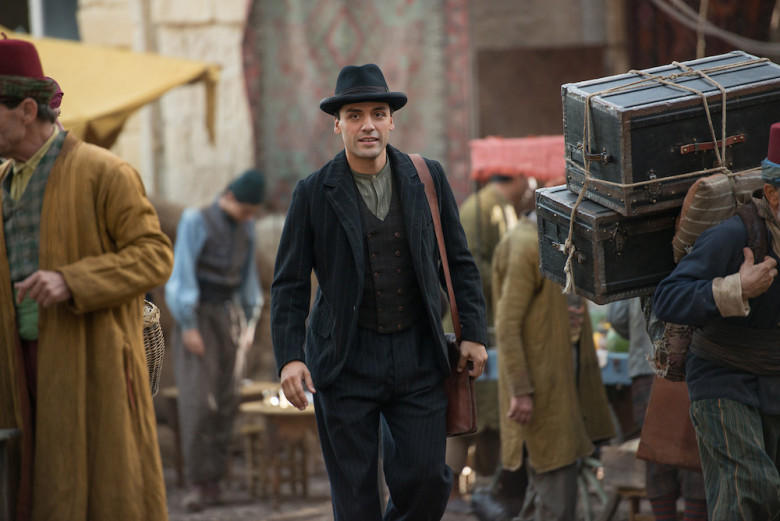
The Nation: The Armenian Genocide Finally Gets its Due With the Film ‘The Promise’

very year, on April 24, a solemn procession of men, women, and children commences in Yerevan, the capital of the former Soviet republic of Armenia. A sea of sad Armenian faces makes its way up to the hill of Tsitsernakaberd to the Armenian Genocide Memorial. It is here that every year the victims of one of the 20th century’s greatest crimes are quietly honored.
An ancient Christian country located just south of Russia and east of Turkey, Armenia has seen much suffering in its long history. However, of all the tragedies experienced by this small yet resilient nation, none compares to the enormity of the Armenian genocide of 1915. The genocide was committed by the Ottoman Empire during World War I. Possessed by a fanatical nationalism, the ruling Young Turk government accused its Christian Armenian subjects of sympathizing with the hated Russian enemy. What followed was the planned, systematic, and ruthless mass murder of as many as 1.5 million Armenian civilians.
“Of all the sufferers of the war,” wrote American diplomat Lewis Einstein in The Nation in 1920, “none have endured more than the Armenians, victims less of its horrors than of the Turkish Government’s diabolical policy of murder.” To this day, Turkey continues to deny the historical reality of the genocide, despite overwhelming scholarly evidence. After over 100 years, the denial of this horrific crime has left the Armenian people in state of incomplete mourning.
Terry George’s forthcoming film The Promise captures the magnitude of this history in a way that no prior film on the genocide has done before. With its sweeping cinematography, powerful acting, and all-encompassing story, it is a truly epic work that effectively and humanely conveys the story of the tragedy.
BRINGING THE TRAGEDY TO THE SCREEN
Given Turkey’s continued stance of denial, making a film about the genocide has never been an easy task. Efforts to produce such a film in Hollywood were consistently blocked by the Turkish government. The most infamous instance of this was in the 1930s, when Ankara pressured MGM into abandoning plans for producing an adaptation of the novel The Forty Days of Musa Dagh, by Austrian-Jewish writer Franz Werfel. The novel was based on real events in which a small community of Armenians living in the mountains of Turkey’s present-day Hatay Province (on the Syrian border) defended themselves against deportation by Ottoman authorities.
Due to Werfel’s Jewish background, the novel was banned in Hitler’s Third Reich and subject to mass book burnings. The book eventually came to the attention of MGM’s Irving Thalberg, who bought the rights and decided to have it produced as a film. Pre-production began in 1934. Clark Gable was to be the star. However, due to pressure from the Turkish government (including anti-Semitic threats by Ankara against MGM as a “Jewish studio”), Louis B. Mayer canceled the project.
“There are numerous reasons why a film like that has not been made by Hollywood over the past century,” said Eric Esrailian, a UCLA doctor who played a major role in the production of The Promise. “It is not as though people have avoided spending money producing other films for all these years. All elements—from studios to producers to actors to crew—have felt pressure or intimidation in one form or another.”
There were indeed films produced about the genocide. The earliest of these, Ravished Armenia (1919), starred a survivor of the genocide, Aurora Mardiganian, and was produced by MGM at a time when Turkey did not have the clout to stop such productions. The box office proceeds went to the aid of Armenian orphans through the Near East Relief. Unfortunately, the film was eventually lost and only recently turned up as a fragmentary copy in post-Soviet Armenia.
The films that followed, such as Henrik Malyan’s Nahapet (1977), Atom Egoyan’s Ararat (2002), Paolo and Vittorio Taviani’s Lark Farm (2007), and Fatih Akin’s The Cut (2014), were unable to reach a mass American audience. Distributed by Warner Bros., Elia Kazan’s America America (1963) vividly depicted the persecution of Armenians and Greeks under Ottoman rule. However, its main focus was the protagonist’s quest to emigrate to the United States.
Given this history, Armenian-American philanthropist Kirk Kerkorianbelieved that the time had come .for a Hollywood film on the genocide. Kerkorian, who passed away in 2015, first conceived of the idea in 2010, but it acquired momentum in 2012 when Kerkorian set up Survival Pictures. He entrusted his close friend Eric Esrailian to the task of bringing the story of the genocide to a general American audience, and enlisted veteran producers Mike Medavoy and William Horberg.
“We wanted to carefully find the right people—committed people with sincere intentions in their hearts—to come together,” said Esrailian. “Thankfully, we were successful, and the result has been everything we hoped for. In addition, we also grew together as a family of people, both in front of and behind the camera. The entire project is thanks to the courage and dedication of Kirk Kerkorian, and people around the world will be thanking him for generations to come.”
AN ALL-ENCOMPASSING EPIC
The Promise is an all-encompassing epic that captures every aspect of the Armenian genocide and of the historical time and place in which the tragedy was situated. Early proposals for films on the genocide tended to focus on specific subjects and stories, such as the heroic defense of Musa Dagh or the suffering of the Armenian composer Komitas. The Promisedoes not limit itself in this regard. Instead, it presents an entire composite picture of the history. All elements of the genocide are brought together into one concise narrative. Ara Sarafian, the director of the Gomidas Institute in London and the leading authority on the history of the genocide in the English language, noted that The Promise “encompasses specific events, as well as generic ones, that defined the destruction of the Armenians.” “The geography of the film, the locations, the movement of people, were all in good order,” he noted. “The cinematography is amazing, and the actors are really good. They hold the narrative together. However, most importantly, the key themes were historically accurate. The producers did not take license to go beyond the historical material at hand yet they managed to capture much of the enormity of the Armenian genocide.”
The film’s story centers on the aspiring doctor Mikael Pogosian (well-portrayed by Oscar Issac) who leaves his native village in southern Turkey to study medicine in Constantinople. Betrothed to a young woman in his village, Mikael falls in love with the beautiful Ana Khesarian (Charlotte Le Bon), a French-Armenian woman, in Constantinople. However, she is also involved with Associated Press reporter Chris Myers (Christian Bale). In the midst of this love story, all three of the characters personally experience the genocide unfolding before them in different ways. Overall, though, it is clearly Isaac’s character, Mikael, who emerges as the main protagonist of the film. He is almost like a hero in a work by one of the great Armenian national writers like Raffi or Khachatur Abovian, yet his experiences are based entirely on actual historical events.
“The film’s main characters are fictional, but they are an amalgam of profiles,” said Esrailian. “We wanted to involve the viewer in the film’s story and to open the door to interest in historical events that have been denied and suppressed for decades. We also wanted to highlight the patterns of man’s inhumanity to man that are sadly being replicated in the world today.”
Director Terry George succeeds masterfully in concisely capturing the entire scope of the history of the genocide. The fictional village of Siroun (meaning “beautiful” in the Armenian language) in Southern Turkey, in an area that Armenians know by the name “Cilicia,” perfectly represents the pre-genocide Ottoman Armenian village life. It captures an idyllic time, highlighting the continuity of local Armenian life and customs before they were destroyed. The aspiring doctor Mikael represents the hope of the Armenian community for a better future in the Ottoman Empire.
Mikael’s journey to Constantinople (Istanbul) reveals yet aspect of Ottoman Armenian life before the genocide: the prosperous intellectual, political, and financial class of Armenians in the Ottoman capital. The film shows their prosperous homes, churches, and trading communities. Sporting the latest European fashions, yet part of the fabric of Ottoman cultural and social life, these Armenians lived between Europe and Asia in a city straddling both continents.























